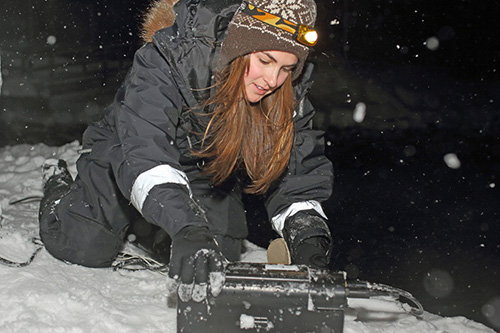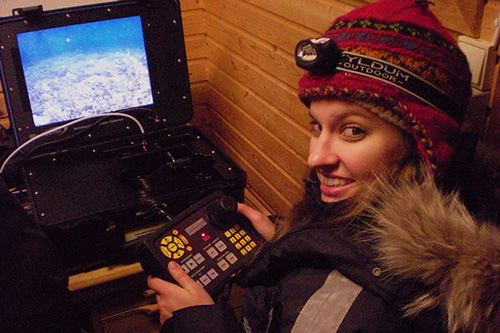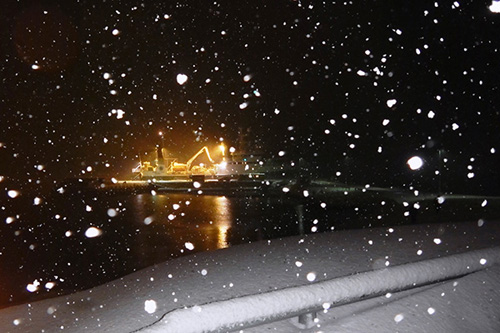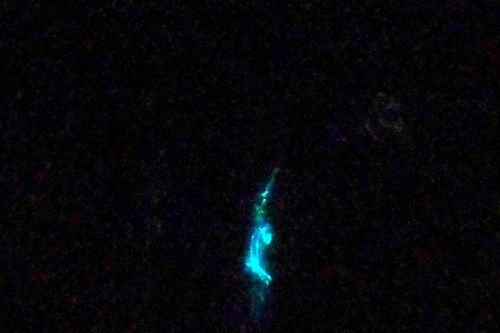Arctic excursion explores how sea life copes with continuous winter darkness
When the North Pole tilts away from the sun during the winter, the Arctic region plunges into weeks of continuous darkness. The sun never peeks above the horizon, casting only a twinge of blue twilight at midday, and the moon dimly illuminates the landscape at night if conditions are clear.
People living in this “polar night” have adapted to the darkness using artificial light, but how ocean inhabitants cope remains to be seen.
Students and faculty from the University of Delaware’s School of Marine Science and Policy in the College of Earth, Ocean, and Environment (CEOE) joined an international group of researchers in Norway this month to better understand how marine organisms there survive when the sunlight disappears. Organized through the Norwegian University Centre in Svalbard (UNIS), the month-long field course provides hands-on learning for students and valuable data collection for instructors.

Graduate student Heather Cronin conducting fieldwork in Norway’s polar night. Photos by Jan Sivert Hauglid/UNIS, courtesy of Kaytee Pokrzywinski, and by Heather Cronin
Traditionally the polar night has been thought to be a biological wasteland. Relatively recent studies, however, show there to be significant activity in this light-limited environment. Algae, for example, are capable of using even low levels of light for photosynthesis.
Based from the archipelago Svalbard, north of mainland Norway, researchers are mapping where organisms such as krill, snails and sea jellies dwell in the surrounding Arctic Ocean this time of year. Using a remotely operated vehicle (ROV) equipped with video, sonar and acoustic technologies, so far they have found whelks, polar cod, anemones, macro algae and small crustaceans along the seafloor.
“I imagined there would be some life here, characterized by a few keystone species, but not much,” said Kaytee Pokrzywinski, a doctoral candidate in marine biosciences. “It’s actually quite the contrary and refreshing to see that the polar night is a very diverse and active system.”

Kaytee Pokrzywinski driving a remotely operated vehicle (ROV). Photos by Jan Sivert Hauglid/UNIS, courtesy of Kaytee Pokrzywinski, and by Heather Cronin
Pokrzywinski helped make a time-lapse video, viewable through a class blog, that shows snails scooting around the seafloor and a dead cod slowly getting eaten away. The approach will help researchers evaluate how the environment changes over the course of a day.
The scientists are also studying bioluminescence, or the light that animals can produce themselves using specialized organs. They use underwater equipment to detect the intensity and duration of bioluminescent light and determine the source. Jonathan Cohen, a CEOE faculty member with expertise in marine vision, is helping the group investigate the visual capabilities of krill, ctenophores and other bioluminescent creatures.
Learning how to work in the dark and cold with sensitive scientific equipment is part of the learning experience. School of Marine Science and Policy Director Mark Moline is on-site teaching how to use underwater robotics with ROVs and autonomous underwater vehicles (AUVs).

The research vessel Helmer Hansen. Photos by Jan Sivert Hauglid/UNIS, courtesy of Kaytee Pokrzywinski, and by Heather Cronin
The frigid cold causes batteries in instruments to lose power quickly, sometimes dying before sampling is finished. Algae can clog propellers on the ROVS, making it difficult to capture data from kelp forests. When need be, Moline and other scientists specially trained to scuba dive in such conditions can gather additional samples.
For the students, the course combines both the technological and biological sides of collecting scientific information. Graduate student Heather Cronin said the experience opened her eyes to a whole new way of viewing marine biology.
“There is just something so exciting about going out into a cold, dark and snowy fjord and watching a plankton net come up from 70 meters filled with a bright blue-green glow from bioluminescent plankton, or driving an ROV under a dock that is covered in snow up to your knees, and seeing a community of kelp, crabs, krill and amphipods — all perfectly happy down there in the frigid water,” Cronin said. “I am interested to see the kind of picture this diverse data set paints of marine life during the polar night.”

A bioluminescent organism retrieved during sampling. Photos by Jan Sivert Hauglid/UNIS, courtesy of Kaytee Pokrzywinski, and by Heather Cronin
– Article by Teresa Messmore
*Source: University of Delaware
